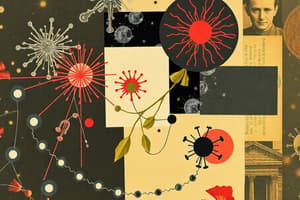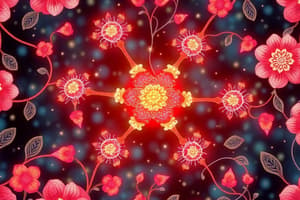Podcast
Questions and Answers
¿Cuál es la función principal de la vía del complemento?
¿Cuál es la función principal de la vía del complemento?
- Formar poros en la membrana de patógenos para inducir su lisis (correct)
- Bloquear la adhesión de bacterias a las células del huésped
- Activar la fagocitosis de patógenos
- Inhibir la replicación de virus
¿Qué proteína es clave para iniciar la vía clásica del complemento?
¿Qué proteína es clave para iniciar la vía clásica del complemento?
- Factor B
- MBL
- C3
- C1 (correct)
¿Cuál de las siguientes afirmaciones sobre la vía de las lectinas es FALSA?
¿Cuál de las siguientes afirmaciones sobre la vía de las lectinas es FALSA?
- Es iniciada por la proteína MBL en lugar de C1
- Involucra la activación de C3 y C5 por distintas convertasas
- Reconoce patógenos con abundancia de manosa en su superficie
- Utiliza un mecanismo completamente diferente a la vía clásica (correct)
La C3-convertasa de la vía alternativa está formada por:
La C3-convertasa de la vía alternativa está formada por:
¿Cuál de las siguientes proteínas NO forma parte del complejo de ataque a la membrana?
¿Cuál de las siguientes proteínas NO forma parte del complejo de ataque a la membrana?
¿Qué función cumple el factor P en la vía alternativa del complemento?
¿Qué función cumple el factor P en la vía alternativa del complemento?
¿Cuál es uno de los recursos del sistema inmunitario que actúa rápidamente y de forma genérica?
¿Cuál es uno de los recursos del sistema inmunitario que actúa rápidamente y de forma genérica?
¿Qué función desempeñan los fragmentos ligeros 'a' generados tras la proteólisis en el sistema del complemento?
¿Qué función desempeñan los fragmentos ligeros 'a' generados tras la proteólisis en el sistema del complemento?
¿Cuál de las siguientes NO es una manera de activar el complemento?
¿Cuál de las siguientes NO es una manera de activar el complemento?
¿Cuál es la función principal de las proteínas del complemento en el sistema inmunitario?
¿Cuál es la función principal de las proteínas del complemento en el sistema inmunitario?
¿Por qué se generan dos fragmentos tras la proteólisis durante la activación del sistema del complemento?
¿Por qué se generan dos fragmentos tras la proteólisis durante la activación del sistema del complemento?
¿Qué característica distingue a C2 de las demás proteínas del complemento en su activación?
¿Qué característica distingue a C2 de las demás proteínas del complemento en su activación?
¿Qué proteína expresan las células sanas para atrapar a C4b e impedir la formación de C3-convertasa clásica?
¿Qué proteína expresan las células sanas para atrapar a C4b e impedir la formación de C3-convertasa clásica?
¿Qué proteína inactiva C3b dando lugar a iC3b para evitar que se una espontáneamente a las células del huésped?
¿Qué proteína inactiva C3b dando lugar a iC3b para evitar que se una espontáneamente a las células del huésped?
¿Qué proteínas expresan las células del huésped para atrapar a C3b y promover al factor I para bloquear el complemento?
¿Qué proteínas expresan las células del huésped para atrapar a C3b y promover al factor I para bloquear el complemento?
¿Qué proteína bloquea el inicio de la formación del complejo de ataque a la membrana, impidiendo la inserción de C5b a C7?
¿Qué proteína bloquea el inicio de la formación del complejo de ataque a la membrana, impidiendo la inserción de C5b a C7?
¿Cuál es el mecanismo basado en un conjunto de proteínas, es decir, de la inmunidad humoral?
¿Cuál es el mecanismo basado en un conjunto de proteínas, es decir, de la inmunidad humoral?
¿Cómo se activa el sistema del complemento mediante anticuerpos y azúcares extraños?
¿Cómo se activa el sistema del complemento mediante anticuerpos y azúcares extraños?
¿Qué complejo es formado por la unión de una segunda C3b y tiene actividad C5-convertasa?
¿Qué complejo es formado por la unión de una segunda C3b y tiene actividad C5-convertasa?
¿Qué función cumple la opsonización dentro del sistema del complemento?
¿Qué función cumple la opsonización dentro del sistema del complemento?
¿Qué función tienen los eritrocitos expresando receptores CR1 en relación con el sistema del complemento?
¿Qué función tienen los eritrocitos expresando receptores CR1 en relación con el sistema del complemento?
¿Cómo se regulan las reacciones del sistema del complemento para evitar daños a las células sanas del cuerpo?
¿Cómo se regulan las reacciones del sistema del complemento para evitar daños a las células sanas del cuerpo?
¿Cuál es el mecanismo por el cual las células fagocitarias detectan fácilmente los patógenos opsonizados?
¿Cuál es el mecanismo por el cual las células fagocitarias detectan fácilmente los patógenos opsonizados?
¿Qué efecto tiene el canal formado por el complejo de ataque a la membrana en la lisis celular?
¿Qué efecto tiene el canal formado por el complejo de ataque a la membrana en la lisis celular?
Flashcards
Complement System's Main Function
Complement System's Main Function
The primary role of the complement system is to form pores in pathogen membranes, leading to lysis (cell destruction).
Classical Pathway Initiator
Classical Pathway Initiator
C1 is the key protein that starts the classical complement pathway.
Lectin Pathway's Key Feature
Lectin Pathway's Key Feature
The lectin pathway utilizes a mechanism distinct from the classical pathway to activate the complement system.
Alternative Pathway C3-Convertase
Alternative Pathway C3-Convertase
Signup and view all the flashcards
MAC's Excluded Component
MAC's Excluded Component
Signup and view all the flashcards
Factor P's Role in Alternative Pathway
Factor P's Role in Alternative Pathway
Signup and view all the flashcards
Complement System: Fast and Generic
Complement System: Fast and Generic
Signup and view all the flashcards
Complement Fragment 'a' Function
Complement Fragment 'a' Function
Signup and view all the flashcards
Complement Activation Methods
Complement Activation Methods
Signup and view all the flashcards
Complement's Main Function
Complement's Main Function
Signup and view all the flashcards
Complement Proteolysis: Dual Fragments
Complement Proteolysis: Dual Fragments
Signup and view all the flashcards
C2's Unique Activation
C2's Unique Activation
Signup and view all the flashcards
C4bp's Role in Complement Control
C4bp's Role in Complement Control
Signup and view all the flashcards
Factor I's Role in Complement Regulation
Factor I's Role in Complement Regulation
Signup and view all the flashcards
Host Cell Complement Inhibitors
Host Cell Complement Inhibitors
Signup and view all the flashcards
Protein S: MAC Blocker
Protein S: MAC Blocker
Signup and view all the flashcards
Complement System: Humoral Immunity Mechanism
Complement System: Humoral Immunity Mechanism
Signup and view all the flashcards
Complement Activation by Antibodies and Sugars
Complement Activation by Antibodies and Sugars
Signup and view all the flashcards
C3b-Bb-C3b: C5-Convertase Complex
C3b-Bb-C3b: C5-Convertase Complex
Signup and view all the flashcards
Opsonization: Pathogen Elimination Enhancement
Opsonization: Pathogen Elimination Enhancement
Signup and view all the flashcards
Erythrocytes and Complement: CR1 Receptors
Erythrocytes and Complement: CR1 Receptors
Signup and view all the flashcards
Complement Regulation: C1 Inhibitor
Complement Regulation: C1 Inhibitor
Signup and view all the flashcards
Phagocytosis: Complement's Role in Recognition
Phagocytosis: Complement's Role in Recognition
Signup and view all the flashcards
MAC Channel: Cell Lysis
MAC Channel: Cell Lysis
Signup and view all the flashcards
Study Notes
Vía Clásica del Complemento
- La proteína C1 es un complejo proteico que se une a la primera proteína del complemento y la proteoliza, activando C2 y C4.
- Los fragmentos producidos, C4b y C2a, proteolizan y activan C3, convirtiéndose en C3-convertasa.
- El complejo C4b-C2a-C3b proteoliza y activa C5, convirtiéndose en C5-convertasa.
Vía de las Lectinas
- La vía de las lectinas es similar a la vía clásica, pero con la proteína MBL (lectina de unión a manosa) en lugar de C1.
- MBL se une a azúcares de bacterias y proteoliza y activa C4 y C2.
Vía Alternativa
- La vía alternativa se activa cuando C3 se hidroliza espontáneamente en C3a y C3b.
- C3b se une a una superficie patógena y hidroliza al factor B con ayuda del factor D, formando el complejo C3b-Bb.
Función del Sistema del Complemento
- El sistema del complemento es una de las primeras líneas de defensa, reconociendo y eliminando patógenos en su entrada.
- Las proteínas del complemento actúan secuencialmente para eliminar al patógeno.
- Los fragmentos ligeros "a" atraen a células pro-inflamatorias y fagocíticas que ayudan a eliminar al patógeno.
Regulación del Sistema del Complemento
- Las células sanas expresan proteínas como C4bp, MCP, CR1 y DAF para protegerse del sistema del complemento.
- La proteína S bloquea la formación del complejo de ataque a la membrana.
- CD59 bloquea la formación del complejo de ataque a la membrana en el último paso.
Consecuencias del Complemento
- Formación del complejo de ataque a la membrana, lo que causa la lisis celular.
- Opsonización, marcando a los patógenos para que sean detectados por células fagocitarias.
- Recolectar patógenos, ya que los eritrocitos unen y arrastran patógenos cubiertos de C3b.
Studying That Suits You
Use AI to generate personalized quizzes and flashcards to suit your learning preferences.



